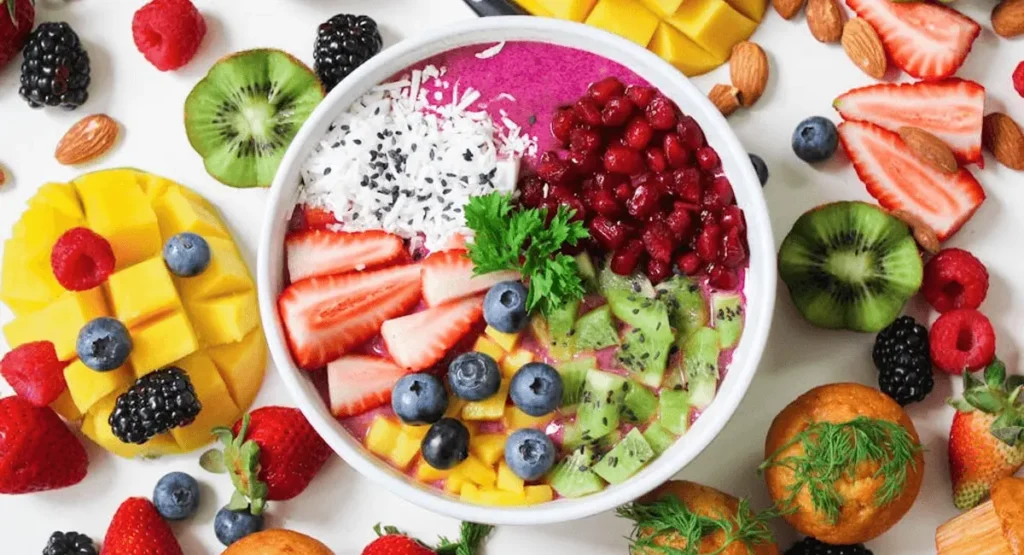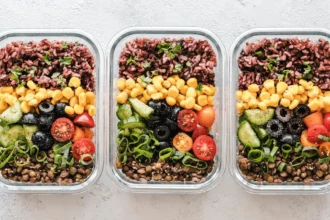
In a world flooded with conflicting nutrition advice, fad diets, and miracle supplements, the simple truth about healthy eating has become surprisingly elusive.
One day you’re told to avoid carbs entirely, the next you’re hearing that fat is the enemy. Sound familiar?
The reality is that eating healthy doesn’t require extreme measures, expensive superfoods, or complicated meal plans. It’s about understanding fundamental nutrition principles and making sustainable changes that fit your lifestyle.
This comprehensive guide will cut through the noise and provide you with evidence-based, practical strategies for building a healthier relationship with food.
You’ll discover what foods truly nourish your body, which ones to limit, and most importantly, how to create lasting habits that support your long-term health and wellbeing.
Whether you’re just starting your wellness journey or looking to refine your current approach, this guide will serve as your roadmap to eating healthy for life.
Understanding Nutrition Fundamentals
Before diving into specific food recommendations, it’s crucial to understand the basic building blocks of nutrition.
Your body requires a complex array of nutrients to function optimally, and knowing how these work together will help you make informed food choices.
Macronutrients: Your Body’s Primary Fuel Sources
Macronutrients are the nutrients your body needs in large quantities to provide energy and support essential functions. The three main macronutrients are proteins, carbohydrates, and fats, each serving unique and vital roles.
Proteins are the building blocks of life, literally. They’re essential for muscle growth and repair, immune function, hormone production, and maintaining healthy skin, hair, and nails. According to the U.S. Dietary Guidelines for Americans, your body needs approximately 0.8 grams of protein per kilogram of body weight daily, though this increases if you’re physically active or recovering from illness. Quality protein sources include lean meats, fish, eggs, dairy products, legumes, nuts, and seeds.
Carbohydrates are your body’s preferred energy source, particularly for your brain and muscles during exercise. Despite popular diet trends that demonize carbs, they’re essential for optimal health. The key is choosing complex carbohydrates like whole grains, vegetables, and fruits over refined sugars and processed foods. These provide sustained energy, fiber, and important nutrients.
Fats play crucial roles in hormone production, nutrient absorption, brain function, and cell membrane health. Healthy fats from sources like avocados, olive oil, nuts, seeds, and fatty fish support heart health and help you feel satisfied after meals. Aim for fats to comprise about 20-35% of your daily calories.
Micronutrients: Small but Mighty
While needed in smaller quantities, vitamins and minerals are just as important as macronutrients. These micronutrients support countless bodily functions, from energy production to immune system strength. Vitamin D supports bone health and immune function, B vitamins help convert food into energy, vitamin C acts as a powerful antioxidant, and minerals like iron, zinc, and magnesium support everything from oxygen transport to muscle function.
The best strategy for getting adequate micronutrients is eating a varied diet rich in colorful fruits and vegetables, whole grains, lean proteins, and healthy fats. Each color in fruits and vegetables represents different beneficial compounds, which is why nutrition experts recommend “eating the rainbow.”
Quality Over Quantity: Why Nutrient Density Matters
While calories do matter for weight management, focusing solely on calorie counting misses the bigger picture. A 200-calorie donut and 200 calories of mixed nuts with an apple provide vastly different nutritional value. The nuts and apple offer protein, healthy fats, fiber, vitamins, and minerals that support your health, while the donut provides primarily empty calories with little nutritional benefit.
Nutrient-dense foods give you the most nutritional bang for your caloric buck. These foods are rich in vitamins, minerals, fiber, and other beneficial compounds relative to their calorie content. Examples include leafy greens, berries, fatty fish, eggs, and legumes.
Hydration: The Often Overlooked Essential
Water makes up about 60% of your body weight and is involved in virtually every bodily function. Proper hydration supports digestion, nutrient transport, temperature regulation, joint lubrication, and waste elimination. Most adults need about 8-10 cups of fluid daily, though this varies based on activity level, climate, and overall health.
Signs of good hydration include pale yellow urine, consistent energy levels, and supple skin. Don’t wait until you feel thirsty to drink water, as thirst is actually a late indicator of dehydration.
Healthy Eating Foods
Building a healthy diet starts with knowing which foods deserve the starring roles on your plate. These nutrient powerhouses should form the foundation of your eating pattern.
Vegetables: Nature’s Multivitamins
Vegetables are among the most nutrient-dense foods available, providing essential vitamins, minerals, fiber, and antioxidants with very few calories. Dark leafy greens like spinach, kale, and arugula are particularly nutritious, offering folate, vitamin K, iron, and nitrates that support heart health.
Cruciferous vegetables such as broccoli, Brussels sprouts, and cauliflower contain compounds that may help protect against certain cancers. Colorful vegetables like bell peppers, carrots, and sweet potatoes provide beta-carotene and other antioxidants that support eye health and immune function.
Aim to fill half your plate with vegetables at most meals. Fresh, frozen, and even canned vegetables (without added sodium) all count toward this goal. Don’t be afraid to experiment with different cooking methods like roasting, grilling, or steaming to find preparations you enjoy.
Fruits: Nature’s Candy with Benefits
Fruits provide natural sweetness along with fiber, vitamins, antioxidants, and other beneficial plant compounds. Berries are particularly rich in antioxidants and have been linked to improved brain health and reduced inflammation. Citrus fruits provide vitamin C and folate, while bananas offer potassium and vitamin B6.
While fruit contains natural sugars, the fiber content helps slow absorption and prevent blood sugar spikes. Whole fruits are always preferable to fruit juices, which lack fiber and can be high in concentrated sugars.
Lean Proteins: Building and Maintaining Your Body
Quality protein sources support muscle maintenance, immune function, and satiety. Research from Harvard’s T.H. Chan School of Public Health shows that diets emphasizing fish consumption, like the Mediterranean diet, are linked to reduced heart disease and improved cognitive function. Poultry, lean cuts of meat, and eggs are excellent animal-based protein sources.
Plant-based proteins like legumes, quinoa, nuts, and seeds offer protein along with fiber, healthy fats, and various micronutrients. You don’t need to eat animal products to meet your protein needs, but plant-based eaters should pay attention to getting all essential amino acids through varied protein sources.
Whole Grains: Sustained Energy and Fiber
Unlike refined grains, whole grains retain their bran and germ, providing fiber, B vitamins, and minerals. Options like quinoa, brown rice, oats, and whole wheat provide sustained energy and help maintain stable blood sugar levels. The fiber in whole grains also supports digestive health and may help lower cholesterol levels.
When shopping, look for products that list whole grains as the first ingredient and contain at least 3 grams of fiber per serving.
Healthy Fats: Essential for Optimal Function
Monounsaturated and polyunsaturated fats support heart health, brain function, and nutrient absorption. Avocados, olive oil, nuts, seeds, and fatty fish are excellent sources. These fats help you feel satisfied after meals and support the absorption of fat-soluble vitamins A, D, E, and K.
Omega-3 fatty acids, found in fatty fish, walnuts, and flaxseeds, are particularly important for brain health and reducing inflammation throughout the body.
Foods to Limit or Avoid When Eating Healthy
While no foods need to be completely off-limits, certain items provide little nutritional value and may harm your health when consumed regularly. Understanding which foods to limit and why can help you make better choices.
Ultra-Processed Foods: The Modern Health Challenge
Ultra-processed foods are industrial formulations that typically contain five or more ingredients, many of which you wouldn’t find in a typical kitchen. These include packaged snacks, sugary cereals, frozen meals, and fast food items. They’re often high in added sugars, unhealthy fats, and sodium while being low in fiber and essential nutrients.
Research has linked high consumption of ultra-processed foods to increased risk of obesity, heart disease, type 2 diabetes, and certain cancers. These foods are often designed to be hyper-palatable, making it easy to overconsume them.
Instead of completely avoiding these foods, which can lead to feelings of deprivation, focus on making them occasional treats rather than dietary staples. When you do choose processed foods, read labels carefully and opt for options with shorter ingredient lists and recognizable ingredients.
Added Sugars: Hidden in Plain Sight
The average American consumes about 17 teaspoons of added sugar daily, far exceeding the recommended 6 teaspoons for women and 9 teaspoons for men according to the American Heart Association.. Added sugars provide empty calories and can contribute to weight gain, tooth decay, and increased risk of chronic diseases.
Sugar hides in many unexpected places, including salad dressings, pasta sauces, bread, and yogurt. Learning to identify sugar’s many names on ingredient labels can help you make more informed choices. Look out for high fructose corn syrup, cane sugar, brown rice syrup, and agave nectar, among others.
Unhealthy Fats: Not All Fats Are Created Equal
While healthy fats are essential, trans fats and excessive saturated fats can harm your health. Trans fats, found in some processed foods and partially hydrogenated oils, raise bad cholesterol levels and lower good cholesterol. Many countries have banned trans fats, but they may still appear in some processed foods.
Saturated fats, found in red meat, full-fat dairy, and tropical oils, should be consumed in moderation. While recent research suggests saturated fats may not be as harmful as once thought, limiting them to less than 10% of daily calories is still recommended by major health organizations.
Excess Sodium: A Silent Health Threat
Most Americans consume far more sodium than the recommended 2,300 milligrams per day, with much of it coming from processed and restaurant foods rather than the salt shaker. Excess sodium can contribute to high blood pressure, heart disease, and stroke.
Reading nutrition labels and choosing lower-sodium options when available can help reduce your intake. Cooking more meals at home also gives you control over sodium levels in your food.
Alcohol: Moderation is Key
While moderate alcohol consumption may have some health benefits, excessive drinking poses significant health risks. The definition of moderate drinking is up to one drink per day for women and up to two drinks per day for men. Excessive alcohol consumption can lead to liver disease, increased cancer risk, and negative interactions with medications.
If you choose to drink alcohol, do so mindfully and within recommended guidelines. Remember that alcohol provides empty calories and can lower inhibitions around food choices.
Building Sustainable Eating Habits
Knowledge about nutrition is just the first step. The real challenge lies in translating that knowledge into consistent, healthy behaviors. Building sustainable eating habits requires a strategic approach that acknowledges both the psychological and practical aspects of dietary change.
Start Small: The Power of Incremental Change
One of the biggest mistakes people make when trying to eat healthier is attempting to overhaul their entire diet overnight. This all-or-nothing approach often leads to feelings of overwhelm and eventual abandonment of healthy eating goals. Instead, focus on making small, manageable changes that you can maintain long-term.
Consider starting with just one change, such as adding a serving of vegetables to one meal per day or switching from sugary drinks to water with lunch. Once this becomes automatic, add another small change. This approach, known as habit stacking, allows you to build momentum without feeling deprived or overwhelmed.
Research shows that it takes an average of 66 days for a new behavior to become automatic, though this varies depending on the complexity of the habit and individual factors. Be patient with yourself and celebrate small victories along the way.
Meal Planning: Your Secret Weapon
Successful healthy eating rarely happens by accident. It requires planning, preparation, and intentionality. Meal planning doesn’t have to be complicated or time-consuming, but it can be the difference between reaching for nutritious foods or defaulting to less healthy convenience options.
Start by planning just three to four meals for the week. Choose recipes that use similar ingredients to minimize waste and shopping complexity. Batch cooking components like grains, proteins, and roasted vegetables can provide building blocks for multiple meals throughout the week.
Invest time in weekend meal prep, even if it’s just washing and chopping vegetables or preparing grab-and-go snacks. Having healthy options readily available makes it much easier to make good choices when you’re tired or pressed for time.
Mindful Eating: Reconnecting with Your Body’s Signals
In our fast-paced world, many people have lost touch with their natural hunger and fullness cues. Mindful eating practices can help you reconnect with these signals and develop a healthier relationship with food.
Try eating without distractions like television, phones, or computers. Focus on the colors, textures, flavors, and aromas of your food. Chew slowly and put your fork down between bites. This not only enhances your enjoyment of food but also gives your brain time to register fullness signals, which can take up to 20 minutes.
Pay attention to how different foods make you feel both during and after eating. Notice which foods provide sustained energy and which ones leave you feeling sluggish or craving more food shortly after eating.
Managing Emotional and Social Eating
Food serves many purposes beyond nutrition. It’s often connected to emotions, social situations, celebrations, and comfort. Understanding your personal eating triggers can help you develop healthier coping strategies.
Common emotional eating triggers include stress, boredom, loneliness, and fatigue. Instead of immediately reaching for food when these feelings arise, try pausing and asking yourself if you’re truly physically hungry. If not, consider alternative ways to address the underlying emotion, such as going for a walk, calling a friend, or practicing deep breathing.
Social situations can also challenge healthy eating habits. Prepare strategies for dining out, parties, and family gatherings. Focus on socializing rather than food, eat a small healthy snack before attending events, and don’t be afraid to speak up about your dietary preferences.
Creating a Supportive Environment
Your environment plays a crucial role in your food choices. Making small changes to your surroundings can make healthy choices easier and less healthy options less convenient.
Stock your kitchen with nutritious staples and minimize the presence of highly processed foods. If you buy treats, store them in opaque containers in less accessible locations. Keep healthy snacks visible and easily accessible.
Involve family members or roommates in your healthy eating goals. When everyone in the household is on board, it’s much easier to maintain healthy habits. Consider cooking together, trying new recipes, or starting a family garden.
Practical Implementation Tips
Knowing what to eat is one thing, but successfully implementing healthy eating habits in real life requires practical skills and strategies. These actionable tips will help you navigate common challenges and make healthy eating more convenient and enjoyable.
Decoding Nutrition Labels
Understanding how to read nutrition labels is an essential skill for making informed food choices. Start with the serving size, as all other information on the label is based on this amount. Many packages contain multiple servings, so you may need to multiply the numbers if you plan to eat the entire package.
Pay attention to calories, but don’t let them be your only consideration. Look at the fiber content (aim for at least 3 grams per serving), added sugars (choose options with less), and sodium levels. The ingredient list is equally important – ingredients are listed by weight from most to least, so the first few ingredients make up the majority of the product.
Look for products with shorter ingredient lists containing recognizable ingredients. If you can’t pronounce an ingredient or don’t know what it is, that’s a red flag that the product is highly processed.
Healthy Cooking Methods
How you prepare food can significantly impact its nutritional value. Some cooking methods preserve nutrients better than others, while some can even enhance the bioavailability of certain compounds.
Steaming vegetables helps retain water-soluble vitamins that might be lost in boiling water. Roasting vegetables at high heat can concentrate flavors and may increase the availability of certain antioxidants. Grilling and broiling are excellent ways to cook proteins without adding extra fats.
When sautéing, use small amounts of healthy oils like olive oil or avocado oil. Avoid deep frying, which adds unnecessary calories and may create harmful compounds. Experiment with herbs and spices instead of relying on salt for flavor – many herbs and spices have their own health benefits.
Budget-Friendly Healthy Eating
One common misconception is that eating healthy is expensive. While some healthy foods do cost more than processed alternatives, there are many strategies for eating well on a budget.
Buy seasonal produce, which is typically less expensive and at peak flavor and nutrition. Frozen fruits and vegetables are often more affordable than fresh and are just as nutritious since they’re frozen at peak ripeness. Canned beans, lentils, and fish are inexpensive protein sources that keep well in the pantry.
Buying in bulk can save money on staples like grains, nuts, and seeds. Consider joining a wholesale club or shopping at farmers markets near closing time when vendors may offer discounts.
Cook more meals at home, which is almost always less expensive than eating out or buying prepared foods. Batch cooking and meal prep can help you make the most of your grocery budget by reducing food waste.
Navigating Dining Out
Eating out doesn’t have to derail your healthy eating goals. With some planning and smart choices, you can enjoy restaurant meals while staying on track with your nutrition goals.
Review menus online before arriving at restaurants so you can make thoughtful choices without pressure. Look for dishes that are grilled, baked, steamed, or roasted rather than fried. Ask for dressings and sauces on the side so you can control the amount you use.
Don’t be afraid to make special requests – most restaurants are happy to accommodate reasonable modifications like substituting vegetables for fries or preparing food without added salt. Consider sharing large portions or immediately boxing up half your meal to avoid overeating.
Managing Cravings Intelligently
Cravings are a normal part of the human experience, and completely ignoring them often backfires. Instead of fighting cravings, try to understand what’s driving them and find healthier ways to satisfy them.
Sometimes cravings indicate nutrient deficiencies. Craving chocolate might signal a need for magnesium, while craving salty foods might indicate dehydration or electrolyte imbalance. Before reaching for the craved food, try drinking water and eating a balanced meal.
When you do indulge cravings, do so mindfully. Choose a small portion of what you’re craving and eat it slowly, paying attention to the taste and texture. Often, a few mindful bites can satisfy a craving better than mindlessly consuming a large quantity.
Common Myths and Misconceptions
The nutrition world is filled with myths and misconceptions that can make healthy eating more confusing and stressful than it needs to be. Understanding the truth behind these common beliefs can help you make more informed decisions about your diet.
The Fad Diet Trap
New diets seem to emerge constantly, each promising to be the ultimate solution for weight loss and health. Whether it’s keto, paleo, intermittent fasting, or the latest celebrity-endorsed eating plan, these approaches often share common characteristics: they’re restrictive, promise quick results, and eliminate entire food groups or macronutrients.
While some people may experience short-term success with fad diets, research consistently shows that extreme dietary restrictions are difficult to maintain long-term. Most people regain lost weight within a year of stopping restrictive diets, and the cycle of restriction and regain can be harmful both physically and psychologically.
Instead of searching for the perfect diet, focus on developing sustainable eating patterns that you can maintain for life. The best eating plan is one that includes foods you enjoy, fits your lifestyle and budget, and provides adequate nutrition for your individual needs.
Carbohydrates: Friend or Foe?
Perhaps no macronutrient has been more demonized in recent years than carbohydrates. Low-carb diets have gained popularity, leading many people to believe that all carbs are bad for health and weight management. This oversimplification ignores the important differences between types of carbohydrates.
Refined carbohydrates like white bread, sugary cereals, and candy provide quick energy but little nutritional value. They can cause rapid spikes in blood sugar followed by crashes that leave you feeling hungry and tired. However, complex carbohydrates from whole grains, vegetables, and fruits provide sustained energy, fiber, and important nutrients.
Your brain relies primarily on glucose (a simple sugar derived from carbohydrates) for fuel, and completely eliminating carbs can lead to fatigue, difficulty concentrating, and mood changes. The key is choosing quality carbohydrate sources and pairing them with protein and healthy fats to stabilize blood sugar levels.
The Fat Fear Legacy
For decades, dietary fat was vilified as the cause of heart disease and obesity, leading to the development of countless low-fat and fat-free products. We now know that this approach was misguided and that healthy fats are essential for optimal health.
Not all fats are created equal, but the blanket avoidance of dietary fat can actually harm your health. Healthy fats from sources like avocados, nuts, olive oil, and fatty fish support heart health, brain function, and hormone production. They also help you feel satisfied after meals and can actually aid in weight management by reducing cravings and overeating.
The real culprits in the obesity epidemic appear to be ultra-processed foods high in both refined carbohydrates and unhealthy fats, along with increased portion sizes and decreased physical activity. Including moderate amounts of healthy fats in your diet is not only safe but beneficial.
Supplement Myths and Realities
The supplement industry is worth billions of dollars and markets products with promises of improved health, increased energy, and protection against disease. While some supplements can be beneficial in certain situations, they’re not magic bullets and cannot compensate for a poor diet.
Most people can meet their nutritional needs through a varied, balanced diet. However, some nutrients are difficult to obtain in adequate amounts from food alone, such as vitamin D (especially for those living in northern climates), vitamin B12 (for vegans), and omega-3 fatty acids (for those who don’t eat fish).
Before starting any supplement regimen, consult with a healthcare provider who can assess your individual needs based on your diet, health status, and risk factors. Remember that supplements are not regulated as strictly as medications, so quality and potency can vary significantly between brands.
One-Size-Fits-All Fallacies
Social media and popular diet books often promote the idea that there’s one perfect way of eating that works for everyone. This ignores the reality that nutritional needs vary based on genetics, age, sex, activity level, health status, cultural background, and personal preferences.
What works well for your friend, favorite influencer, or coworker may not be the best approach for you. Some people thrive on higher-carb diets while others feel better with more protein and fat. Some people do well with three meals a day while others prefer smaller, more frequent meals.
Pay attention to how different foods and eating patterns make you feel, and don’t be afraid to experiment to find what works best for your body and lifestyle. The goal is to find a sustainable approach that supports your health and fits into your life, not to follow someone else’s prescription perfectly.
Long-term Success Strategies
Creating lasting change in your eating habits requires more than just knowing what to eat. It demands a strategic approach that accounts for the inevitable challenges, setbacks, and life changes that occur over time. These strategies will help you maintain healthy eating habits for the long haul.
Setting Realistic and Achievable Goals
Goal setting is crucial for long-term success, but many people set themselves up for failure by creating unrealistic expectations. Instead of vague goals like “eat healthier,” create specific, measurable, achievable, relevant, and time-bound (SMART) goals.
Examples of SMART nutrition goals include “eat three servings of vegetables every day this week,” “pack a healthy lunch four days this week instead of buying fast food,” or “try two new healthy recipes this month.” These goals are specific enough to track progress and achievable enough to build confidence and momentum.
Break larger goals into smaller steps. If your ultimate goal is to lose 30 pounds, focus on losing the first 5 pounds while establishing healthy habits that will support continued progress. Celebrate these smaller victories along the way – they’re building blocks toward your larger goals.
Tracking Progress Beyond the Scale
While weight can be one measure of health, it’s far from the only indicator of progress. In fact, focusing exclusively on weight can be misleading and discouraging, especially when you’re building muscle through exercise or when normal fluctuations occur due to hydration, hormones, or other factors.
Consider tracking other markers of progress such as energy levels throughout the day, sleep quality, mood stability, digestive health, and how your clothes fit. Keep a simple journal noting how you feel after meals and throughout the day. Many people find that eating healthier improves their energy, concentration, and overall sense of wellbeing long before any changes appear on the scale.
Take body measurements and progress photos if body composition changes are important to you. Muscle tissue is denser than fat tissue, so you might lose inches and improve your body composition while maintaining the same weight.
Handling Setbacks with Self-Compassion
Setbacks are a normal part of any behavior change process, not signs of failure or lack of willpower. How you respond to setbacks often determines whether they become temporary detours or permanent derailments.
When you find yourself eating in ways that don’t align with your goals, avoid the all-or-nothing mentality that leads to extended periods of unhealthy eating because you’ve already “blown it.” Instead, treat each meal as a fresh opportunity to make choices that support your health.
Practice self-compassion by talking to yourself the way you would talk to a good friend facing similar challenges. Focus on what you can learn from the setback and how you can prepare differently for similar situations in the future.
Adapting to Life’s Changes
Life is dynamic, and your eating habits need to be flexible enough to adapt to changing circumstances. Job changes, family situations, health issues, and other life events can all impact your ability to maintain consistent eating patterns.
Instead of viewing these changes as obstacles, see them as opportunities to develop new skills and strategies. Moving to a new city might be a chance to explore different grocery stores and restaurants. Starting a new job might require adjusting your meal prep schedule but could also introduce you to new colleagues interested in healthy eating.
Build flexibility into your approach from the beginning. Have backup plans for busy days, travel situations, and unexpected events. The more adaptable your healthy eating strategies are, the more likely you are to maintain them long-term.
Making It a Lifestyle, Not a Diet
The most successful approach to healthy eating is viewing it as a lifestyle rather than a temporary diet. Diets have end dates; lifestyles are ongoing. This shift in mindset can be liberating and lead to more sustainable changes.
Focus on adding positive foods and behaviors rather than restricting and eliminating. Instead of “I can’t eat sugar,” try “I choose to fuel my body with nutritious foods most of the time.” This positive framing makes healthy eating feel like self-care rather than punishment.
Allow for flexibility and enjoyment in your eating. Include foods you love in moderate amounts, and don’t label foods as “good” or “bad.” This balanced approach reduces the likelihood of feeling deprived and eventually rebelling against your healthy eating goals.
Frequently Asked Questions (FAQ)
Q: How long does it take to see results from eating healthier?
The timeline for seeing results from healthier eating varies depending on what type of results you’re looking for and your starting point. Many people notice improvements in energy levels and digestion within just a few days to a week of eating more nutritious foods. You might find that you sleep better, have more stable energy throughout the day, and experience less bloating or digestive discomfort.
Mood and mental clarity improvements often occur within the first two weeks as blood sugar levels stabilize and nutrient intake improves. Weight changes, if that’s a goal, typically become noticeable after 2-4 weeks of consistent healthy eating, though this varies greatly among individuals.
Long-term health benefits like improved cholesterol levels, blood pressure, and reduced inflammation markers usually become apparent after 2-3 months of sustained healthy eating. Remember that these internal changes are occurring even before you see external results, so trust the process and focus on how you feel rather than just how you look.
Q: Can I still eat my favorite foods while eating healthy?
Absolutely! One of the biggest mistakes people make when trying to eat healthier is thinking they have to give up all their favorite foods forever. This all-or-nothing approach often leads to feelings of deprivation and eventual abandonment of healthy eating goals.
The key is following the 80/20 rule – aim to make nutritious choices about 80% of the time, leaving room for treats and indulgences the remaining 20% of the time. This might mean enjoying a slice of birthday cake at a celebration, having pizza night with your family, or savoring your favorite ice cream occasionally.
You can also experiment with healthier versions of your favorite foods. Love pasta? Try whole grain versions or spiralized vegetables. Crave sweets? Explore naturally sweetened options or smaller portions of high-quality treats. The goal isn’t perfection – it’s finding a sustainable balance that allows you to enjoy food while supporting your health.
Q: What’s the best diet for weight loss?
The most effective diet for weight loss is one that creates a moderate calorie deficit while providing adequate nutrition and is sustainable for your lifestyle. Despite what the diet industry wants you to believe, there’s no single “best” diet that works for everyone.
Research shows that people can lose weight successfully on various eating patterns – Mediterranean, low-carb, plant-based, or simply reducing portion sizes while eating a variety of foods. The common factor among successful approaches is that they help people eat fewer calories than they burn while maintaining adequate nutrition.
Focus on changes you can maintain long-term rather than extreme restrictions that lead to rapid weight loss followed by regain. Sustainable weight loss typically occurs at a rate of 1-2 pounds per week through a combination of healthy eating and regular physical activity. The habits you build during weight loss are the same ones that will help you maintain your results.
Q: How do I meal prep without getting bored?
Meal prep doesn’t have to mean eating the same thing every day. Smart meal prepping is about preparing components that can be mixed and matched throughout the week to create variety while saving time.
Try batch cooking versatile ingredients like grains (rice, quinoa, farro), proteins (grilled chicken, baked tofu, hard-boiled eggs), and roasted vegetables. These can be combined in different ways – grain bowls one day, salads the next, and wraps another day.
Prepare different sauces, dressings, and seasonings to change the flavor profile of the same base ingredients. A batch of roasted vegetables can become Mediterranean with olive oil and herbs, Asian-inspired with sesame oil and ginger, or Mexican-flavored with cumin and lime.
Plan for some meals to be fully prepped while others only have components prepared. This gives you the convenience of meal prep while maintaining some spontaneity in your eating.
Q: Is organic food worth the extra cost?
Whether organic food is worth the extra cost depends on your budget, priorities, and which specific foods you’re considering. Organic foods are produced without synthetic pesticides, fertilizers, or GMOs, but they’re not necessarily more nutritious than conventional foods.
If budget is a concern, prioritize organic versions of foods on the “Dirty Dozen” list – produce items that tend to have higher pesticide residues when grown conventionally. These typically include strawberries, spinach, kale, peaches, and apples. The “Clean Fifteen” list includes produce with lower pesticide residues where buying organic may be less important, such as avocados, corn, and pineapple.
For animal products, organic often means better welfare standards and no antibiotics or added hormones, which some people prioritize. Remember that the most important thing is eating plenty of fruits and vegetables, whether organic or conventional. Don’t let budget constraints prevent you from eating produce altogether.
Q: How much protein do I really need?
Protein needs vary based on your age, sex, activity level, and health goals. The basic recommendation for sedentary adults is 0.8 grams per kilogram of body weight per day, but most people benefit from higher amounts.
Active individuals, older adults, and those trying to build or maintain muscle mass typically need 1.2-2.0 grams per kilogram of body weight daily. For a 150-pound (68 kg) person, this translates to about 82-136 grams of protein per day.
Distribute protein throughout the day rather than consuming it all in one meal. Aim for 20-30 grams of protein at each meal to optimize muscle protein synthesis. Both animal and plant proteins can meet your needs, though plant-based eaters should focus on variety to ensure they get all essential amino acids.
Q: What should I do if I have food allergies or dietary restrictions?
Food allergies and dietary restrictions don’t have to prevent you from eating healthily – they just require more careful planning and creativity. Start by identifying safe foods within each food group and building your meals around those options.
Work with a registered dietitian who has experience with your specific restrictions to ensure you’re meeting all your nutritional needs. They can help you identify potential nutrient gaps and suggest appropriate foods or supplements.
Learn to read labels carefully and be aware of hidden sources of allergens. Many packaged foods contain common allergens in unexpected places. When dining out, don’t hesitate to ask detailed questions about ingredients and preparation methods.
Focus on whole, unprocessed foods as much as possible, as these are less likely to contain unexpected allergens or additives. Build a repertoire of safe recipes and meal ideas so you always have go-to options.
Q: How do I handle social pressure around food choices?
Social situations can be challenging when you’re trying to maintain healthy eating habits, but with preparation and confidence, you can navigate them successfully. Remember that your health goals are valid and important, and you don’t need to justify your choices to others.
Before social events, eat a small healthy snack so you’re not overly hungry, which can lead to poor food choices. Focus on the social aspects of gatherings rather than the food. Bring a healthy dish to share so you know there will be at least one option that aligns with your goals.
When others comment on your food choices, keep responses simple and positive. You might say, “I’m focusing on eating foods that make me feel good” or “I’ve found that eating this way gives me more energy.” Avoid being preachy about your choices, as this can create tension.
Q: Are cheat days or cheat meals okay?
The concept of “cheat” days or meals can be problematic because it implies that certain foods are forbidden and creates a cycle of restriction and guilt. This black-and-white thinking often leads to overindulgence followed by shame, which isn’t conducive to long-term healthy eating habits.
Instead of scheduled cheat days, consider adopting a more flexible approach that allows for treats and indulgences as part of your regular eating pattern. The 80/20 rule mentioned earlier is much more sustainable than extreme restriction followed by extreme indulgence.
When you do choose to eat foods that aren’t typically part of your healthy eating plan, do so mindfully and without guilt. Enjoy the food, savor the experience, and then return to your regular eating patterns at the next meal. This approach helps normalize all foods and reduces the power that “forbidden” foods hold over you.
If you find that having occasional treats leads to extended periods of unhealthy eating, you might benefit from working with a registered dietitian or therapist who specializes in eating behaviors to develop a healthier relationship with food.
Q: What’s the difference between hunger and cravings?
Learning to distinguish between physical hunger and psychological cravings is crucial for developing a healthy relationship with food and maintaining appropriate eating patterns.
Physical hunger develops gradually and is accompanied by physical sensations like a growling stomach, low energy, or difficulty concentrating. True hunger can be satisfied by various foods, and you’ll feel satisfied after eating an appropriate amount. Physical hunger also comes with natural stopping cues when you’ve eaten enough.
Cravings, on the other hand, tend to come on suddenly and are usually for specific foods, often those high in sugar, fat, or salt. Cravings are frequently triggered by emotions, environmental cues (like seeing food advertisements), habits, or memories rather than actual nutritional needs.
Before eating, pause and ask yourself: “Am I physically hungry, or am I experiencing a craving?” If you’re truly hungry, eat a balanced meal or snack. If it’s a craving, try to identify what might be triggering it – stress, boredom, habit, or an emotional state. Address the underlying cause when possible, or if you choose to satisfy the craving, do so mindfully and in moderation.
Conclusion
Embarking on a journey toward healthier eating doesn’t require perfection, extreme restrictions, or expensive superfoods. It’s about making informed choices, developing sustainable habits, and creating a positive relationship with food that nourishes both your body and your life.
Key Takeaways
The foundation of healthy eating rests on several core principles that remain constant despite changing diet trends and conflicting advice. Focus on eating a variety of whole, minimally processed foods including plenty of vegetables, fruits, lean proteins, whole grains, and healthy fats. These nutrient-dense foods provide the vitamins, minerals, fiber, and other compounds your body needs to function optimally.
Quality matters more than strict calorie counting, though being mindful of portion sizes is important for maintaining a healthy weight. Stay adequately hydrated, limit ultra-processed foods and added sugars, and remember that no single food will make or break your health – it’s your overall eating pattern that matters most.
Building sustainable habits requires patience, self-compassion, and flexibility. Start with small changes you can maintain rather than attempting dramatic overhauls that are difficult to sustain. Plan ahead when possible, but also develop strategies for handling unexpected situations and setbacks.
Remember that healthy eating looks different for everyone based on individual needs, preferences, cultural background, and life circumstances. What matters is finding an approach that supports your health while fitting into your lifestyle and bringing you satisfaction and joy.
Your Next Steps
Begin your healthy eating journey by choosing one or two small changes to implement this week. This might be adding a serving of vegetables to one meal per day, switching from sugary drinks to water, or planning and preparing healthy snacks for the workweek.
Assess your current eating habits honestly but without judgment. Keep a simple food diary for a few days to identify patterns, triggers for less healthy choices, and areas where you’d like to make improvements. This baseline will help you set realistic goals and track your progress.
Stock your kitchen with healthy staples and remove or relocate foods that don’t support your goals. Having nutritious options readily available makes healthy choices much easier when you’re busy or tired.
Consider your support system and how you can involve family, friends, or coworkers in your healthy eating goals. Whether it’s cooking together, trying new restaurants, or simply having people who understand and support your choices, social support significantly improves your chances of long-term success.
Your Long-term Vision
Think beyond short-term goals and envision how you want to feel and what you want your relationship with food to look like in the months and years ahead. Healthy eating isn’t a destination you arrive at, but rather an ongoing journey of nourishing your body, supporting your health goals, and enjoying the pleasure that food can bring to your life.
The habits you build today will compound over time, leading to improved energy, better health markers, and a greater sense of wellbeing. You’re investing in your future self with every nutritious choice you make.
Remember that progress isn’t always linear, and perfect consistency isn’t the goal. What matters is getting back on track after setbacks, continuing to learn and adjust your approach as needed, and maintaining a positive relationship with food and your body.
By focusing on nourishment rather than restriction, progress rather than perfection, and sustainability rather than quick fixes, you’ll develop eating habits that support not just your physical health, but your overall quality of life. The journey toward healthier eating is one of the most valuable investments you can make in yourself, and every step forward is worth celebrating.
Start where you are, use what you have, and do what you can. Your future self will thank you for the healthy choices you make today.






5 Comments